If you click on a link and make a purchase we may receive a small commission. Read our editorial policy.
Marvel just made a seismic change to the origin of the X-Men's Nightcrawler and Mystique
Marvel has a huge twist regarding Nightcrawler’s real parents.
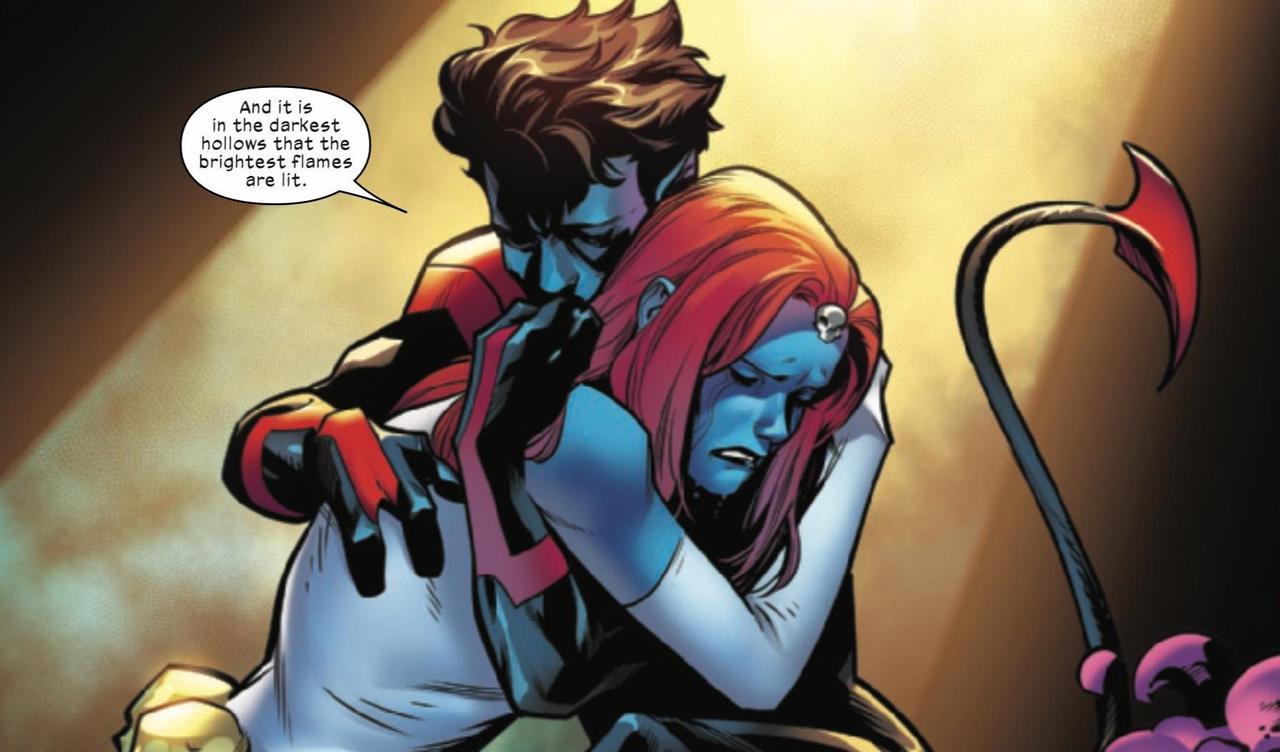
Everything we thought we knew about Nightcrawler’s past is wrong. For years it’s been understood that Kurt Wagner’s mother is Raven Darkholme, the shapeshifting mutant known as Mystique. However, there is more to the story than anybody – even Kurt and Raven - realized. X-Men Origins: Blue #1 (written by Si Spurrier, penciled by Wilton Santos and Marcus To) contained some shocking revelations. What do these revelations mean, and how do they fit in with the X-Men’s history? Read on…
Warning: Spoilers ahead for X-Men Blue: Origins #1!
What was Nightcrawler’s original origin?
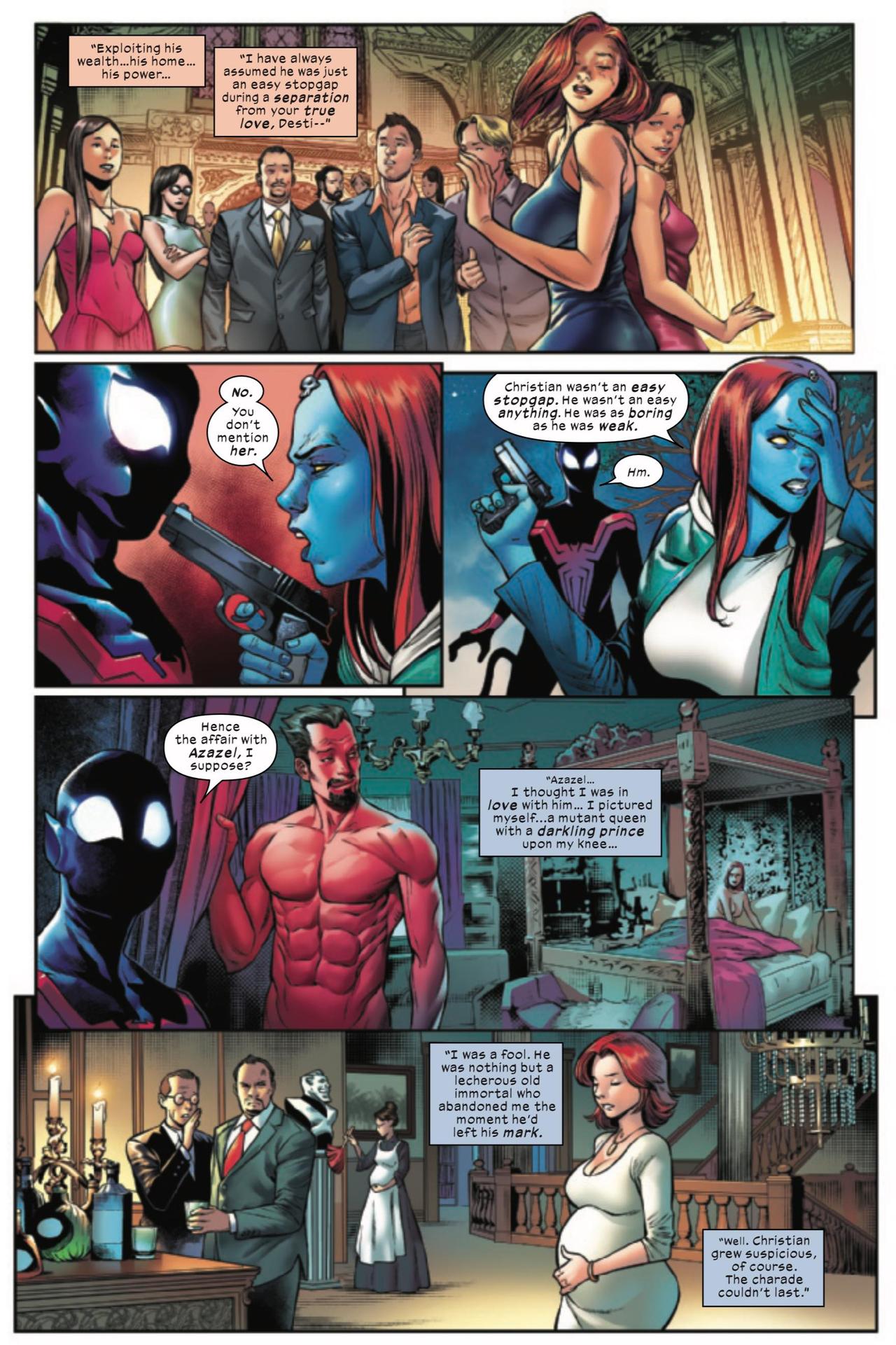
Before we dive into the new revelations, let’s go over the history of Nightcrawler’s origin. Prior to X-Men Blue: Origins #1, Nightcrawler was thought to be the son of Mystique and Azazel. However, the journey to that version of Kurt’s origin was long and interesting.
Nightcrawler was first introduced in Giant-Size X-Men #1 (1975) and there was no mention of who his parents were. His demonic appearance, tail, and blue fur were simply a product of his mutant biology. The character was created by Len Wein and Dave Cockrum, with Chris Claremont taking over scripting duties after Wein’s departure. Over the years, Claremont had a few plans for Kurt’s parentage.
As detailed in Back Issue #29, Claremont wanted to reveal that Nightcrawler was the son of Nightmare, a Doctor Strange villain who ruled the Dream Dimension. Roger Stern, who was writing Doctor Strange at the time, objected to the idea, so Claremont went in another direction.
Kurt’s backstory was expanded in X-Men Annual #4 (1980). We learn that Nightcrawler was raised by a sorceress named Margali Szardos. Margali claims that she found Kurt as a newborn infant, laying next to his dying mother. It turns out, she wasn’t telling the complete story.
Nightcrawler’s connection to Mystique was first teased in Uncanny X-Men #142 (1980). As the X-Men battle Mystique, the villainess shapeshifter surprises Nightcrawler by using his real name. “You…know my name! Who are you,” Kurt asked. “Ask your mother, Margali Szardos. Who would know better than she,” Mystique replied.
The details of Kurt’s backstory begin to change in Uncanny X-Men #177 (1983). Kurt’s foster sister and girlfriend (yup, you read that correctly) Amanda Sefton tells him that as a baby he was found alongside the corpse of his father, not his mother. That same issue features a battle between Mystique and robot versions of the X-Men. Mystique easily kills the robot version of her foster daughter Rogue but hesitates when faced with Nightcrawler. Once again, a connection was being teased.
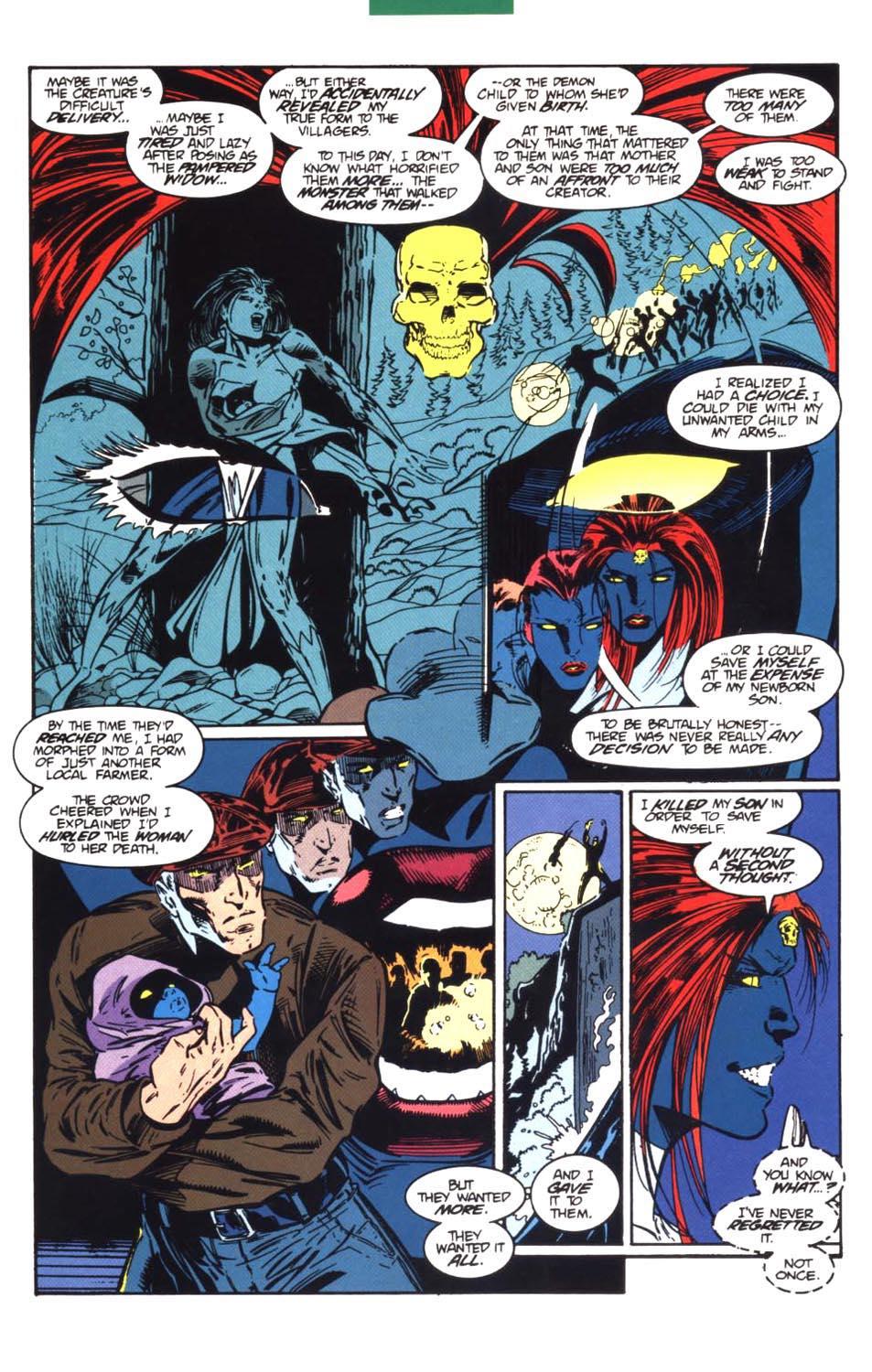
Claremont’s original plan was to reveal that the precognitive mutant known as Destiny was Kurt’s mother, while Mystique was his father (thanks to some genetic shapeshifting). At the time Claremont had written Mystique and Destiny as a couple but was unable to be explicit about it due to concerns from Marvel. As you can imagine, if Marvel was hesitant to make Mystique and Destiny a couple, there was no way they were going to approve Claremont’s plans to reveal Mystique as Kurt’s father. Claremont’s pitch was rejected, but the hints about Kurt’s ties to Mystique continued for years.
After Claremont left the X-Men books, Scott Lobdell picked up the dangling Nightcrawler/Mystique plot thread in X-Men Unlimited #4 (1994). During a conversation with Graydon Creed, Kurt learns that he’s the son of Mystique (disguised as a normal woman) and a deceased German count. Kurt’s unnamed father died under mysterious circumstances sometime before he was born. Once Mystique gave birth, the townspeople were horrified at the appearance of the infant.
Mystique then filled in the rest of the story. She fled the town with baby Kurt, but the angry mob pursued them. In order to escape, Mystique transformed into an adult man, informing the crowd he had killed the “demon woman” and captured her baby. To placate the crowd’s bloodlust, she threw baby Kurt over a waterfall, believing it was the only way to save her life. “I killed my son in order to save myself. Without a second thought. And you know what? I’ve never regretted it,” Mystique coldly states.
This doesn’t answer the question about the other dead bodies the infant was found next to in previous versions of the origin story, but it wouldn’t be X-Men continuity if things weren’t a convoluted mess.
BUT WAIT, THERE’S MORE!
A new wrinkle was added to Nightcrawler’s backstory with the introduction of Azazel in Uncanny X-Men #428 (2003). Azazel was a demonic mutant that looked like a red version of Nightcrawler. Azazel posed as a German nobleman and befriended Baron Christian Wagner (who is named for the first time). Azazel had an affair with Baroness Rachel Wagner, who was secretly Mystique. Once she became pregnant, Azazel left Mystique, breaking her heart.
Mystique killed Christian when he began to suspect that Azazel was the true father of their unborn child. From there, the origin story plays out the same way as it did in X-Men Unlimited #4, with Mystique throwing baby Kurt over a waterfall.
This raises the question of why Kurt took Wagner as his last name if he was unaware of his family history until adulthood. X-Men Origins: Nightcrawler #1 (2010) clears that up by revealing that a priest named Wagner had been kind to Kurt during his youth. However, the flashback issue also altered the circumstances of his birth.
As Kurt’s backstory is recounted, we see Mystique tying the infant to a log and sending him down a river, rather than violently throwing him over a waterfall. The implication is that Mystique wanted to save the child from the mob, rather than kill him.
With all that in mind, how does X-Men Blue: Origins #1 change Kurt’s backstory, without disrupting the convoluted continuity?
Who are Nightcrawler’s parents?
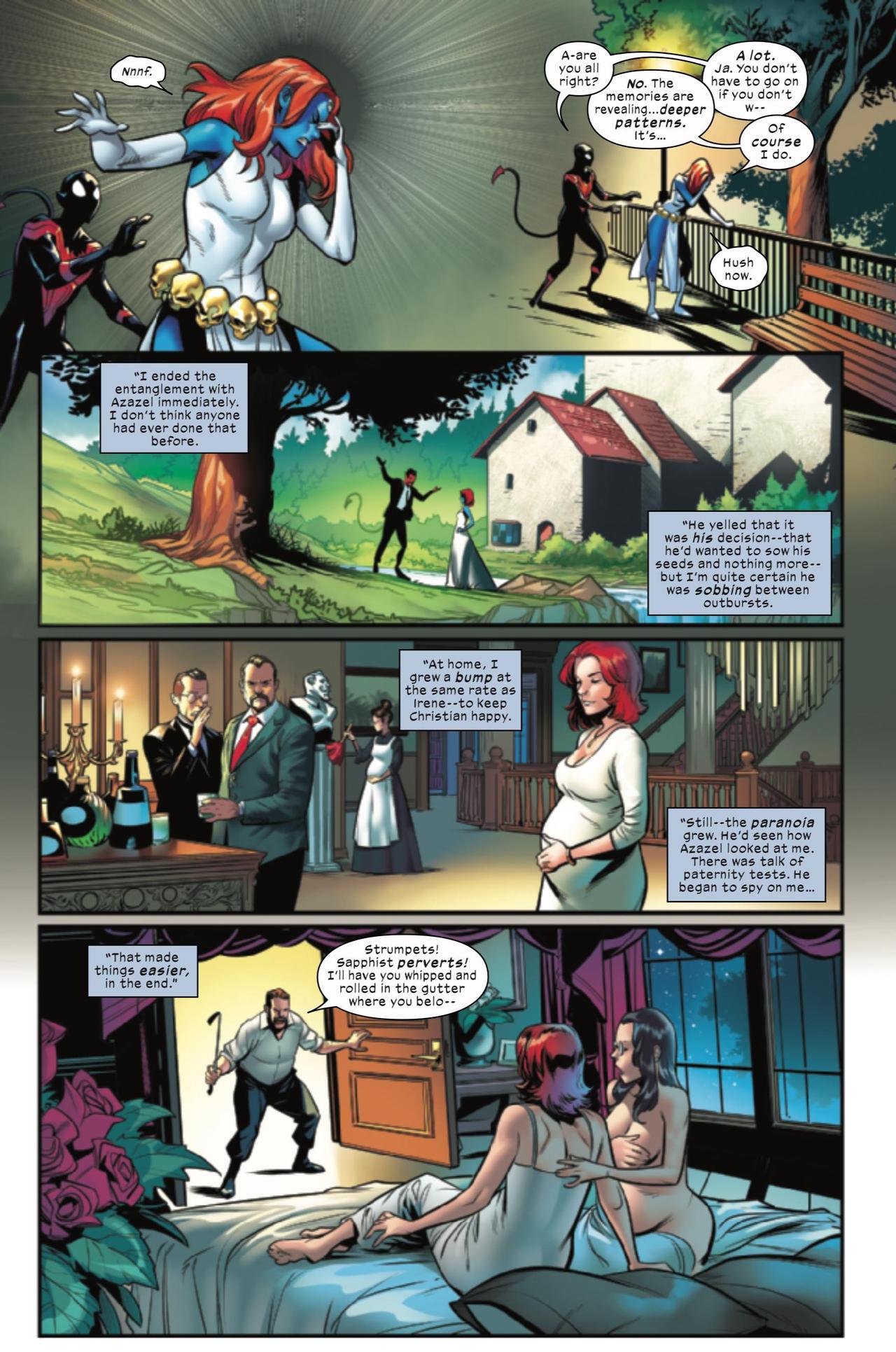
X-Men Blue: Origins catches up with Kurt and Raven, who are reeling from recent events in Uncanny Spider-Man. Mystique has been wandering New York, unbalanced and yelling about her missing baby. Kurt catches up with her and tries to talk her through her delirium. During their conversation, Raven slowly rebuilds her memories, and recounts Nightcrawler’s true origin.
Raven and Destiny had an open relationship prior to Nightcrawler’s birth. This led to Raven’s marriage to Christian Wagner. In order to keep Destiny nearby, Raven hired her as a maid for the Wagner estate. We also learn that Destiny encouraged Mystique to pursue her affair with Azazel.
Raven then recalls Destiny’s desire to start a family. “So we made a baby. Just her and me,” Mystique tells Kurt. Nightcrawler is initially shocked, asking how two women could conceive a child. “You think all I do is shift skin, like a clever blue squid? You think I could do what I do if not for an instinctive command of cells, hormones, ribosomes? You think I can’t rewrite every disgusting trace of sapiens code, if I have to,” Raven explains.
Mystique continues her story, explaining how it was SHE who broke up with Azazel, not the other way around. We see their breakup scene from Uncanny X-Men #428, but with a new twist. “He yelled that it was his decision – that he wanted to sow his seeds and nothing more, but I’m quite certain he was sobbing between outburst,” Mystique recounts. (I enjoyed that touch)
While disguised as Baroness Wagner, Raven grew a baby bump at the same rate as Destiny. However, when Christian caught Raven and Destiny in bed together, Raven killed him. Months later, Destiny gave birth to Kurt, and the doctors were shocked at the baby’s mutant appearance. Destiny told Raven to flee with the baby, and she would join them later.
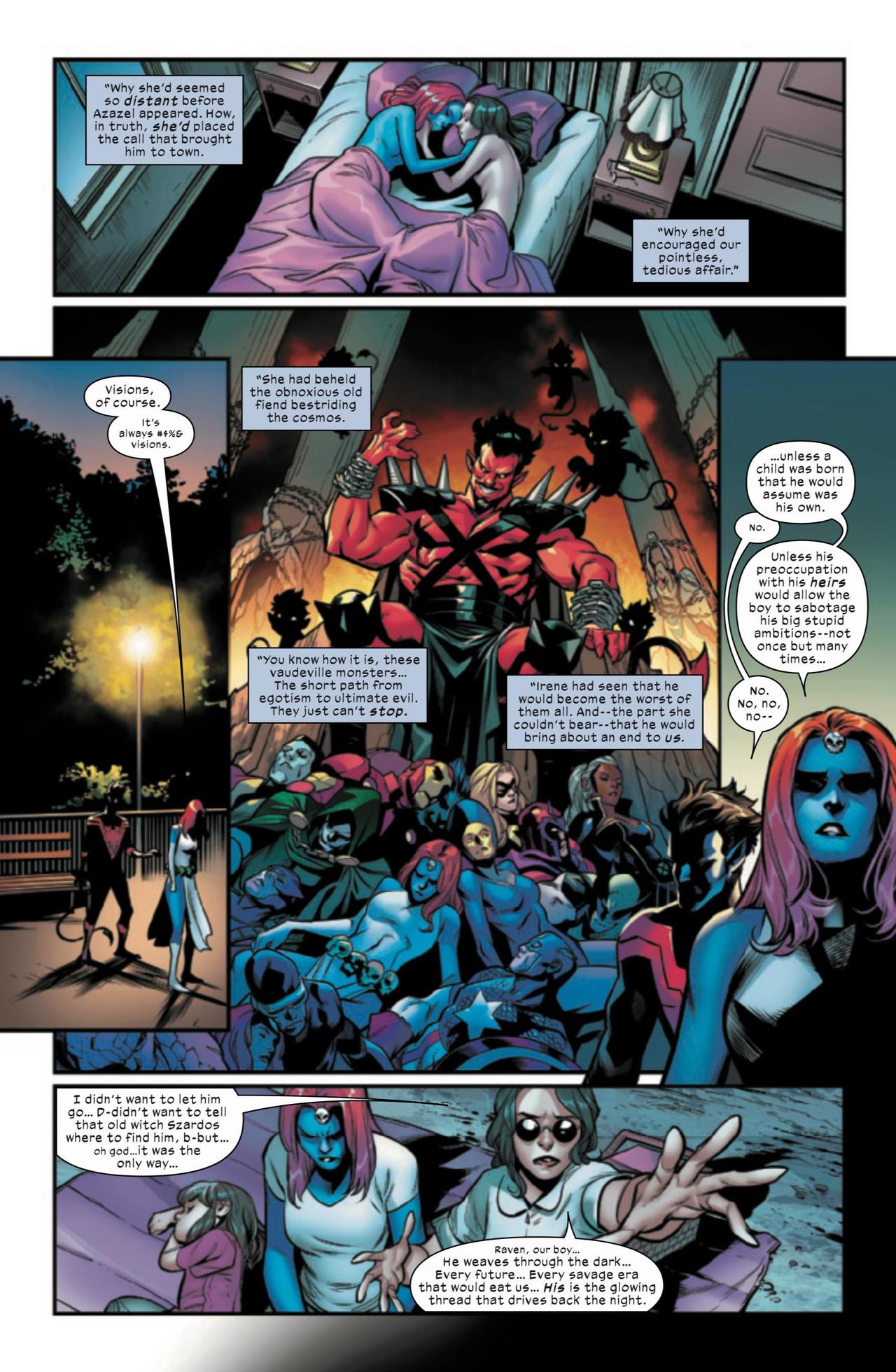
As Raven fled with Kurt, she saw the Wagner estate burning. Fearing for her beloved’s safety, Raven hid baby Kurt by a nearby tree so she could return to town and save Destiny. When Raven returned to the village, Destiny was missing. Heartbroken, she went back to the forest to retrieve baby Kurt, but he was also missing (presumably found by Margali Szardos).
It would be another five years before Raven found Destiny. The prerogative mutant explained that she had engineered Raven’s affair with Azazel. Using her powers, she saw that Azazel would destroy the world unless he was distracted by an heir….or someone he thought was his heir. And so, Destiny tricked Raven into impregnating her, so Azazel would believe he had fathered a child. But Azazel would believe Raven was carrying the child not Destiny. Whew…it’s complicated, isn’t it?
In order to heal from the heartbreak of losing their child, and fix the rift in their relationship, Raven and Destiny sought out Charles Xavier. Destiny had Xavier erase all memories of her pregnancy, and any visions associated with it. However, Raven refused to give up the last link to her lost child. “I wish to be free from the loss and the hate, but I need to know that the boy is mine. I won’t let go of that,” Raven says.
“Ms. Darkholme, I must warn you,” Xavier cautions. “I’ve observed that where memories have been perforated rather than removed, the mind will weave its own stories around the imperfections. Callous choices, false affections. You may find the version you remember even uglier than the truth.”
This explains the various discrepancies in the origin over the years. Charles erases his own memory as well, believing this is a private family matter. So why is Raven able to remember this now?
Well, it's because of the psychic attack at the Hellfire Gala. Due to that attack, Xavier’s memory work was undone, which allowed Mystique to put the pieces back together.
What does this all mean?
This retcon may be a bit convoluted (okay, it’s VERY convoluted), but it’s important for a few reasons. First, it honors the original plan that Chris Claremont had for the character. Claremont wasn’t able to write this story in the 1980s, but comics have come a long way since then. It also makes a Mystique a loving parent, rather than a woman who tried to murder her newborn child.
This story also gets to the core of what the X-Men are about. For years, marginalized readers have been able to relate to the themes of mutant persecution in X-Men comics. Whether it’s race, sexuality, or something else, the X-Men have long been seen as a metaphor for people who are different. While society shuns the X-Men for their differences, Xavier teaches the mutants to celebrate what makes them who they are.
Nightcrawler’s conception is a perfect example. In the year 2023, we have a much different understanding of gender than we did in 1983. Although Raven identifies as a female and uses she/her pronouns, she believes in the fluidity of gender, and transforms herself so she can have a baby with her lover. Modern readers don’t have mutant shapeshifting powers, but they can relate to Raven’s views on gender fluidity.
This is more than an update to Nightcrawler’s origin, it’s a story that makes the X-Men more inclusive, and that should be celebrated.
An advanced review copy for X-Men Blue: Origins #1 was provided ahead of release by Marvel.
What would make Zack Snyder return to superheroes? Frank Miller adaptations
Follow Popverse for upcoming event coverage and news
Find out how we conduct our review by reading our review policy
Let Popverse be your tour guide through the wilderness of pop culture
Sign in and let us help you find your new favorite thing.
















Comments
Want to join the discussion? Please activate your account first.
Visit Reedpop ID if you need to resend the confirmation email.